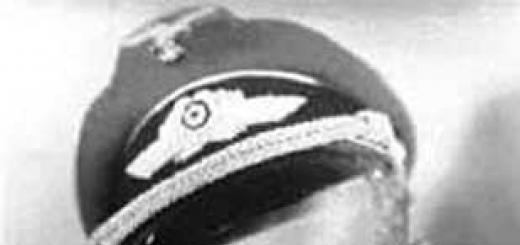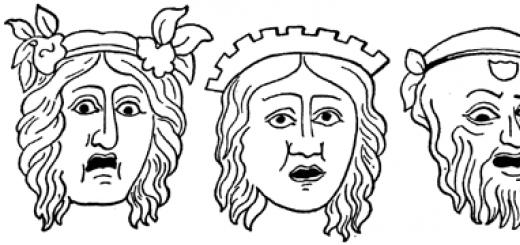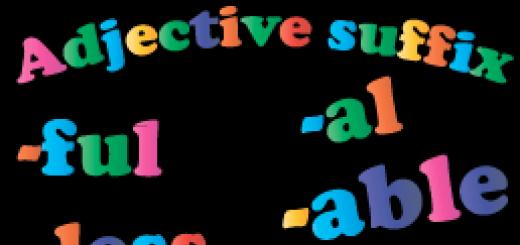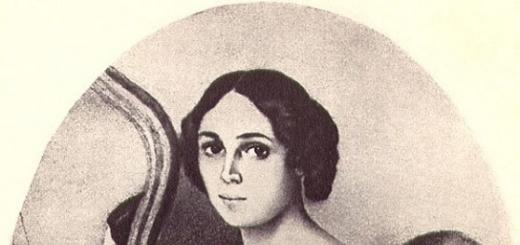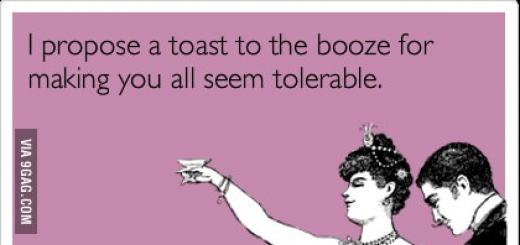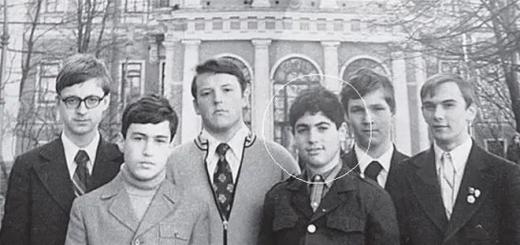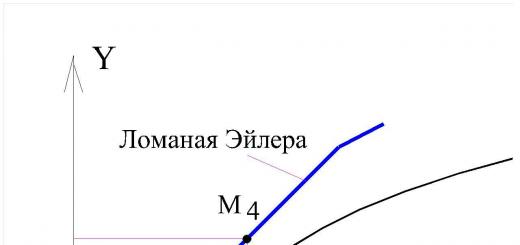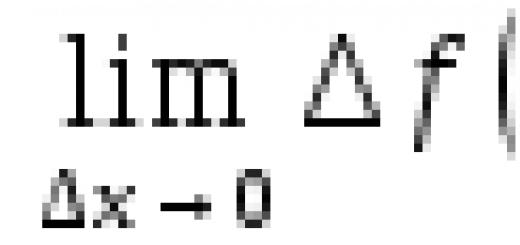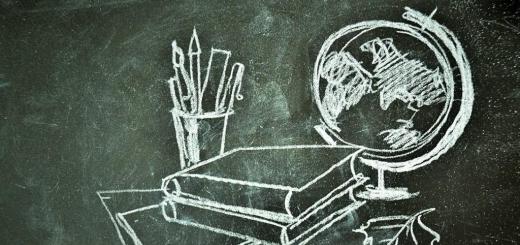Title page
The portfolio begins with a title page, which contains basic information: last name, first name and patronymic, contact information and photo of the student. It is important to let your child choose the photo for the title page.
Section 1. “My World” (“Portrait”)
Here you can place any information that is interesting and important for the child.
1. “Autobiography” - In this section he can place his photographs and sign them.
2. “Essays” – compositions, essays on various topics:
– My name (information about what the name means, why the parents chose this particular name; if the child has a rare or interesting surname, you can explain what it means). (1 class)
– My family (here you can talk about family members, or write a story about your family). (2nd grade)
– My friends (photos of friends, information about their interests, hobbies). (2nd grade)
– My hobbies (you can talk about what your child is interested in, what sections or clubs he is involved in). (3rd grade)
– My small homeland (tell about your hometown, about its interesting places. Here you can also place a route map from home to school, compiled by the child together with his parents, it is important to note dangerous places in it (road intersections, traffic lights).
Section 2 – “My Goals”
My educational plans for the year (classroom and extracurricular activities)
Information about employment in circles, sections, clubs
Section 3 – “Social practice”
Information about orders
- You can design this section using photographs and short messages on the topic:
– Release of a wall newspaper
– Participation in community cleanups
– Speech at the ceremony
Includes data on all types of social practice of students in extracurricular activities (social projects, providing assistance to those in need, etc.).
Section 4 – “My achievements”
This section may include headings:
“Creative works” (poems, drawings, fairy tales, photographs of crafts, copies of drawings that took part in competitions, etc.),
“Awards” (certificates, diplomas, letters of gratitude, etc.)
It is better to arrange the contents of this section in chronological order.
Information about participation in Olympiads and intellectual games
Information about participation in sports competitions and competitions, school and class holidays and events, etc.
Information about participation in project activities
The materials in this block allow you to build a rating of individual results, a rating of achievements, and track the dynamics of changes in learning outcomes.
Section 5 – “My impressions”
Information about visiting a theater, exhibition, museum, school holiday, hike, excursion.
Section 6 – “Working materials”
(all written work, diagnostic work)
RUSSIAN LANGUAGE 1st grade
Mathematics 1st grade
The world around us 1st grade
That's how I read. 1 class
Section 7 – “Feedback and Suggestions”
(in any form)
– Teachers
– Parents
– Additional education teachers
Nothing increases a child’s self-esteem more than a teacher’s positive assessment of his efforts. Here you can write a review or wish, perhaps recommendations, both from a teacher and a parent, both based on the results of the school year and on participation in any event.
Memo for teachers on maintaining a portfolio
1. Involving parents to help fill out sections of the portfolio (especially in 1st grade).
2. Portfolio sections should not be numbered, but arranged in random order (optional).
3. The result of the work is dated so that dynamics can be tracked; the corresponding assessment always compares the child’s current work with earlier work.
4. Do not use the portfolio to compare children with each other!!!
6. Viewing of the portfolio by teachers, parents and other students is permitted only with the knowledge and consent of the student to whom the portfolio belongs.
7. The pages of the portfolio must be beautifully designed; the child must understand the importance of the appearance of the document.
8. It is important that at each stage in the process of moving towards the intended goal, the student’s success is recorded, because success is the best incentive for further development.
9. At the end of the school year, you can make a presentation and determine the winner in the nominations “The most original portfolio”, “For the best design of work”, “For versatility and talent”, “For hard work”.
Interaction with parents
Most parents, being confident that a portfolio will definitely help when entering a university, are very meticulous in filling it out, and some are convinced by teachers of this, creating motivation for creating a portfolio for their children.
It is very important to make parents your allies in the difficult task of collecting a portfolio. Therefore, it is initially worth attracting active, caring parents. A system of advisory assistance is needed: consultations, seminars on designing and filling out portfolio pages.
It is important to teach how to observe, notice everything new and interesting, and be sure to record and write it down. With the help of a portfolio, parents see their child from the outside, his desires, interests.
The portfolio can also be used as additional material when studying a family - its way of life, interests, traditions. Observing children and their parents in the process of creating a portfolio, teachers noted that such events contribute to the establishment of warmer relationships in the family.
One of the main results of working on a portfolio is that parents learn to observe and notice the changes that are taking place, and systematize them. Some help can be provided by reminders and questionnaires, based on which parents will be able to highlight especially bright and interesting moments in the development of their child.
Memo for students on maintaining a portfolio
1. Start your portfolio work with a story about yourself, your family, your hobbies.
2. Compiling a portfolio is not a race for all kinds of certificates. The process of participation itself is important, although a high result, of course, pleases.
3. Fill out the portfolio pages carefully, show your imagination and creativity where necessary, because your portfolio should be different from others.
4. Learn to notice your even small successes, rejoice at them!
5. Apply to filling out your portfolio in a good mood!
Ready-made portfolio templates for schoolchildren. Downloading is free and paid, depending on the quality and uniqueness of the portfolio. Free downloading is possible only with the condition of using it exclusively for the child’s personal purposes. Publishing archives and template sheets on other sites and blogs is not allowed!
Student portfolio in the style of the 2018 FIFA World Cup: 13 blank pages in jpg format |
Student portfolio template in a nautical style from grades 1 to 8: 13 blank pages in jpg format |
||
Student portfolio template in Olympic style Sochi 2014: 16 blank pages in jpg format |
|||
|
High school student portfolio template “From Paris with Love”: 12 blank pages in jpg format |
|||
|
Portfolio template for a high school student in the style of the artist P. Mondrian: 12 blank pages in png format |

2nd grade student
Piliptsova
Stanislava

What's in my name?........................................................ ..........................................4
From the history of Greco-Roman wrestling……………………………………………………...5
Rules of Greco-Roman wrestling…………………………………………………………6
10 commandments of an athlete……………………………………………………...7
I am for a healthy lifestyle………………………………………………………………....9
My hobbies………………………………………………………………………………….11
The brightest event in my life……………………………………………………13
Personality I would like to emulate……………………………….15
My achievements…………………………………………………………………………………16
Additional information worthy of mention……………………..17
Being sporty is now fashionable again!
You will understand a lot with sports.
Sports – and health without pills.
Sports and fun without worries.
Play sports with friends
Believe me, really all year round!


![]()

From the history of Greco-Roman wrestling
Since ancient times, Russian heroes have been famous in Rus'. Even in early childhood, my grandmother read to me about Ilya Muromets, and from then on I began to dream of being like him. Therefore, when I went to first grade, my mother, without hesitation, enrolled me in the Greco-Roman wrestling section. Here I learned a lot about wrestling. This sport has been known since ancient times among many peoples. Wrestling appeared in Rus' a long time ago: there are records that already in the 10th century Russians knew about this type of martial arts. It is known from history that our ancestors had to fight a lot, so without fighting there is nowhere. However, the struggle in Rus' found its application not only in war, but also in everyday life, the Russian peoples made room for it. So, for example, all the holidays could not happen without fights between skilled Russian fighters, showing their skill, strength and courage.
In Ancient Greece, wrestling was the most popular sport. A wrestler received one point when his opponent touched the ground with his back or went out of bounds. Wrestling was the first competition added to the Olympic Games program in addition to running (708 BC). The sport was considered the best expression of strength and was featured in Greek mythology. The most famous wrestler at that time was Milo of Croton, who lived around 520 BC, who won the Olympic Games six times. And for the first time, wrestling competitions were presented at the Summer Olympic Games in 1896 in Athens and since then have been included in the program of each subsequent Games.

Greco-Roman wrestling rules
I often hear the following saying: “If you have strength, you don’t need intelligence.” But I not only strive to be strong and strong, but I also try to learn a lot about Greco-Roman wrestling from the stories of adults, on TV, from the Internet. Mom buys me encyclopedias about sports. And I draw a lot of knowledge from there. After all, to defeat your opponent, it is not enough to have strength. You need to know your opponent’s tactics, the rules of the fight.
Now I know that wrestling competitions take place on a special 8x8 meter mat. The fight consists of three periods of 3 minutes each, with one-minute breaks for rest. We boys are divided into age groups groups and weight categories. The fight takes place in the “stand” or “ground”. This is when one of the wrestlers knees, lying on the chest, on the side, in the “bridge”. If I can force my opponent to touch the mat with both shoulder blades, I am considered the winner. There are many things that should not be done. For example, you can’t grab the neck with both hands, you can’t hit your opponent, you can’t lubricate your body with something before a fight, you can’t argue with the judge, you can’t talk to each other, etc. You must follow the rules unquestioningly, otherwise you may be disqualified.
I haven’t been wrestling for that long – it’s only my second year, but I’m trying hard and working on myself. I already have my first victories in competitions. My coach says that I still have everything ahead of me and that I show promise. The main thing is that I love this sport and am moving forward with slow but confident steps.
Sports help me develop strength, speed, agility, endurance, and a sense of balance. And most importantly, I feel confident and healthy.
Being involved in Greco-Roman wrestling, I began to perceive the sport not as an opportunity to make a career, become a champion, earn a lot of money and world fame. And first of all, as health, as hardening, as work on oneself. After all, he disciplines me better than the strictest parents.

Together with my family, we have compiled 10 commandments of an athlete, which I try to follow.
The most important thing is the father.
The dearest thing is my mother.
The most important thing is health.
The worst thing is vodka.
The worst thing is smoking.
The saddest thing is betrayal.
The dirtiest thing is to lie.
The worst thing is to whine and whine.
The most beautiful thing is to have a dream and strive for it.
Play sports all your life, be cheerful, fit, beautiful and cheerful.

My family is my support

Sport is very important for everyone
He is health and success!









I love tinkering and drawing
I love to dance and perform
My first victory!
Many people know the story of the miraculous healing of Valentin Ivanovich Dikul. It was a person overcoming a terrible illness through incredible efforts and grueling training, thanks to an unshakable will to live and a persistent desire to be healthy.
The miraculously surviving gymnast with paralyzed legs, according to doctors, had no chance of recovery. But Dikul thought differently and did not want to give up. The main goal was to return to a full life and circus art.
Valentin Ivanovich not only independently recovered from the disease, but also began to help people fight the disease.
I wish I could become such a strong, strong-willed person, persistent in achieving my goals! It’s not for nothing that my name STANISLAV is translated as “glorious for its fortress, camp.” I will try very hard to be like my idol V.I. Dikulya.
My classmates entrusted me with the task of being the class leader. And for the second year now I have been trying to justify their trust. I am the best athlete in the class, awarded with certificates and a medal for sports achievements.
There are no unexcused absences on my mark sheet.
Our class (boys) took part in the school competition “When Soldiers Sing”, dedicated to Defender of the Fatherland Day.
We took 1st place among grades 1-2.
I go in for sports because I want to grow up to be a strong, brave person, to become a real man, so that I can protect my loved ones, my family. And, of course, become a worthy defender of your country. When the time comes, I will definitely join the Army and become a brave, courageous soldier.
PORTFOLIO OF PROFESSIONAL ACTIVITIES
COACH-TEACHER BMOU DO "Youth Sports School"
Portfolio(from the French porter - to set out, formulate, carry and folio - sheet, page) - dossier, collection of achievements.
The portfolio of professional activities of a teacher is a form of assessing his professionalism and performance, carried out through an examination.
Maintaining a portfolio involves seeing the “picture” of significant professional results as a whole, ensuring tracking of his individual professional growth, and demonstrating the effectiveness of his work.
The teaching worker himself selects and forms his portfolio, as well as arranges it in a special folder or album.
The structure of the portfolio is presented in the following sections, the content of which practically corresponds to the criteria and indicators of the expert opinion on compliance with a particular qualification category.
Title page(Annex 1)
Business card of a teaching worker
education (educational institution, year of graduation, specialty, qualification)
Confirmed by a copy of the diploma.
job title
kind of sport
experience: teaching _________________
by position __________________
Taken from the work book.
Availability of qualification category _________________
Confirmed by a copy of the previous certification document.
Self-analysis of the activities of a teaching worker
It is written in free form and may have the following structure:
the main ideas that guide the teacher in his activities, identifying the main goals for a specific inter-certification period, ways to achieve goals, the most significant achievements, problems that have arisen and ways to solve them, prospects.
Self-education and advanced training
|
Self-education form |
Supporting materials |
||
Documents confirming this information are certificates, diplomas, certificates, programs of seminars, conferences, gratitude, reviews, etc.
Scientific and methodological activities of teaching staff (work to generalize and disseminate one’s own teaching experience)
1. Availability of own methodological developments ( give a complete list and attach some of them).
|
Name of methodological development |
Creation time |
Distribution method (availability in the institution’s methodological office, posting on the Internet, other sources, etc.) |
|
Confirmed by a certificate certified by the head of the educational institution.
2. Availability of publications on problems of development, upbringing, education of children, generalization of experience.
|
Publication title |
Publication name |
Publishing house |
Year of issue |
Number of pages |
|
It is necessary to attach the title page of the printed publication, the “contents” page and indicate the imprint of the publication.
3. Participation in master classes and open classes
|
Event title |
The date of the |
Supporting documents |
|
4. Participation in seminars and conferences
|
Event title |
The date of the |
Participation form (topic) of experience presentation |
Supporting documents |
|
Confirmed by a summary, registration sheet and feedback (video material).
Student performance and achievements
Information about the compliance of the certified person’s achievements with the criteria for assessing the results of the work of a trainer-teacher is indicated.
Introduce:
certified copies of competition protocols containing information on the number of countries represented at the sports competition and the number of participants (teams).
confirmation that the athleteactually trains with this trainer for a certain number of years (extract from orders on the athlete’s enrollment in a group or copies of group lists).
|
Athlete's name or commands |
Year of birth |
working with an athlete |
Name of competition, discipline |
Competition rank |
Busy place |
|
Personal achievements of a teaching worker
This section contains all the certified documents available to the teacher confirming his individual achievements: official awards, diplomas, letters of gratitude, certificates, grants (documents for receipt), etc.
Official awards (attach supporting documents).
|
Award, title |
Order number and date |
|
| activities teacher currently... |


